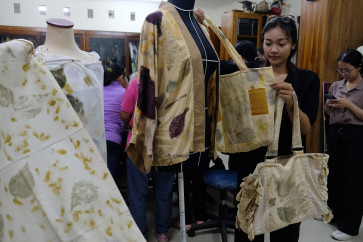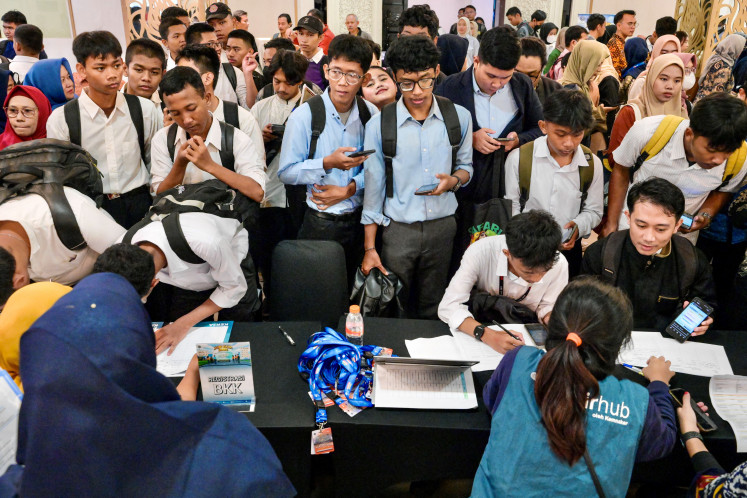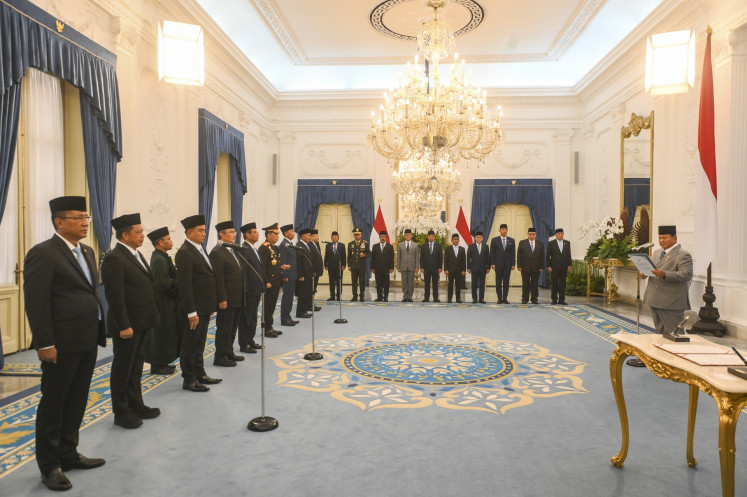Popular Reads
Top Results
Can't find what you're looking for?
View all search resultsPopular Reads
Top Results
Can't find what you're looking for?
View all search resultsThe undead reborn in Indonesia
Letâs get the party started: Members of the IZoC in zombie regalia reach out to touch someone at their last Zombie Walk in January
Change text size
Gift Premium Articles
to Anyone
Let's get the party started: Members of the IZoC in zombie regalia reach out to touch someone at their last Zombie Walk in January.
People were once scared of zombies. Now, everybody wants to be one. A sweeping statement, but you cannot dismiss the numbers. Today zombie culture contributes US$5 billion annually to the world economy. You are only ever a few clicks away from zombie games, contact lenses, toys, clothing, makeup and the ' somewhat disturbing ' zombie dildo.
Zombies only seeped into popular culture 80 years ago. Stories of the Haitian zombi were first retold by GIs returning from the Caribbean in the 1930s. Zombies have since been the subject of movies such as Night of the Living Dead; comics, including Marvel's Tales of the Zombie; and television shows, notably AMC's The Walking Dead, which began life as a graphic novel. The genre hit a dead end in the late 1990s, with many zombie films going straight to DVD, but with the 21st century the zombie was reborn, faster and more deadly than ever.
The Indonesian Zombie Club (IZoC) began life as 'The Thread of the Dead' in Kaskus, Indonesia's biggest online forum. Here fans talked zombie movies and computer games. In July 2008, izoc.org was born and 'elders' from Kaskus created a Facebook group. The infection then began to spread across the archipelago.
IZoC now boasts 5,000 members from Aceh to Papua. After affiliating with other zombie communities, IZoC began to receive invitations from promoters and event organizers.
'In November 2011 at Urban Fest Jakarta, IZoC organized the first Zombie Walk in Indonesia, and in January 2013, the second Zombie Walk was held on Jl. Sudirman: The biggest zombie walk in Asia,' Eric Kairupan, IZoC public relations officer, said.
'We want to grow the community and pass the benefits on to members. The benefits are not financial, but friendship, knowledge, networking and fun,' Eric said, adding that the second Zombie Walk also promoted an antilitter campaign.
Macabre: Eric Kairupan, the spokesman for IZoC (right), poses with fellow ghouls in this undated photo. Eric led a detachment of the undead in makeup to a premiere screening of the zombie epic World War Z in Jakarta on Wednesday evening.
The advance of zombie walks runs parallel to advances in communication. Connectivity mobilized the masses and saw the rise of flash mobs.
Zombie walks originated in Sacramento, the US, in 2001 and spread quickly.
'It's an odd success story. What started as an activity among horror fans has grown into gigantic commercialized events, each with their own variations. Part of the allure of zombie walks is they are just fun,' said Todd Platts, a sociologist studying the historical development of zombies.
In awe of an event he experienced at Comic Con in San Diego, US, Gillian Ang organized The Singapore Zombie Walk (singaporezombies.com) on Halloween 2012, and infected the streets of Singapore.
'The sight of bloody zombies on the streets brought the apocalypse off the screen and in to the real world. I decided to organize a walk myself, assemble a zombie horde and create a platform for the zombie community to indulge zombie fantasies,' Gillian said.
Picture the dead of night; eerie silence blankets your city. Separated from your friends, your nerves are jangled by a piercing shriek and approaching footsteps. A glance out of your hiding place reveals the shuffling undead, soulless eyes searching for the fresh blood they sense in the vicinity. Do you stay hidden or run to a safe zone?
When there's no more room in hell: The dead will walk the earth, or at least around the Hotel Indonesia Traffic Circle during a recent car-free Sunday.
Not a scene from a movie or video game, this is 2.8 Hours Later by Slingshot, a street games company from Bristol, UK.
The real-time game has clocked up 25,000 players since 2010. It is a madcap night out with friends, crossing the city, avoiding infection from the patrolling zombie hordes, concluding at the party at the end of the world; a Zombie Disco, contaminated or not. It's a refreshing twist on the conventional group breakdown of zombie movie survivors, who are often defeated by internal rot rather than the encroaching undead.
'Adrenaline affects social bonds. Adrenalized people form tighter bonds, which feed a strong social experience,' Slingshot director Simon Johnson said.
The logistically heavy, 2.8 Hours Later has nine full time staff and around 250 extras per game. The Singapore Zombie Walk is much less wieldy; for the first event, organizers mapped out a route, obtained permits and guided over 130 zombies around Clarke Quay.
'We provided makeup to a small group but many improvised with DIY materials like wet tissues,'
Gillian said.
Humans (even when zombified) are social beings, eager to learn through play, by exploring situations impossible in our day-to-day lives, in a safe environment and on our own terms. Platts speaks about sociability without subtext; engagement for engagement's sake.
'Zombie walks are social stimulation. The zombies are somewhat incidental, they just happen to be in vogue,' he said.
Lil' zombie: A young cosplayer sports traditional Muslim attire along with his zombie makeup.
But what about the zombiphiles Gillian spoke of creating a platform for? Who are these fans and what do they do with their zombie downtime?
'Zombies are not stagnant: They are multifaceted. In Asia, we only know them from films. Communities like IZoC give people somewhere to share this fascination,' Eric said.
Popularity breeds emulation. If something is a hit ' and makes money ' there is a rush to produce similar hits. Case-in-point zombies' horror brethren, vampires and the Twilight franchise.
Zombie activity can be viewed as an incarnation of fear for the end of civilization. Post-9/11 paranoia may be part of this, but advances in technology and modes of consumption have created a perfect environment for zombiefests, where producers are also consumers.
Zombies have infected the mainstream. Attracted to the spectacle, to the suspension of belief, or just to taking time out to live a different life, people are converging to face the end of the world together.
' Photos Courtesy of iZoc and Kamego













